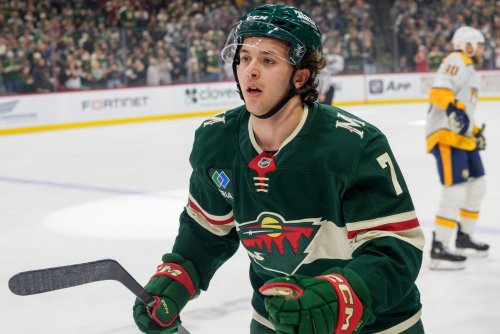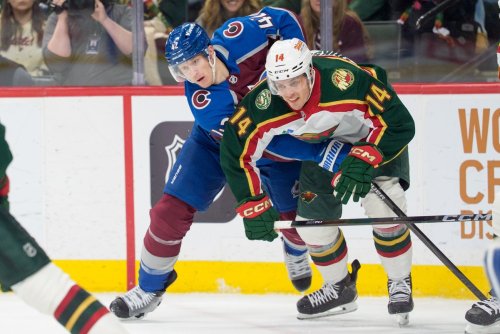
If I had taken a poll of fans of the Minnesota Wild last night, asking what is the biggest concern about the team heading into their game against the Dallas Stars, I would have gotten some good interesting answers. Some people might have looked at the high-scoring Stars and said "limiting Jamie Benn and Tyler Seguin to only two goals apiece." Other might have reasonably looked at the Wild itself and said "goaltending." Probably more than a few might have said "How do we attach Jason Pominville to an intercontinental train and also is that legal?"
Even given the sheer variety of all these reasonable and not-so-reasonable concerns, I don't think anyone had John Klingberg on the top of their list. He's a standout defenseman, who has lit up the Stars' blueline this year, but if you looked at the classic, hey-Norm-Green--would-you-kindly-eat-just-a-truckload-of-unpleasant-things, Stars-Wild matchup, shots from the point are rarely a big issue. Recent Stars' rosters have never been known for the prowess of their defensive players especially in converting on opportunities from the point. That is, until John Klingberg and co. began to emerge.
For so much of the past two seasons, the Wild have been a stellar shot suppression team. Their strategy has forced the puck to the outside edges of the sheet and has prevented mobile defensemen from simply walking the puck into dangerous zones. Their premier defensemen in Ryan Suter and Jonas Brodin play cerebral, calculated games based on preventing, not causing offense.
Last night, that strategy looked like it might just work, limiting Seguin and Benn's explosive ability on the ice. Yes, they scored, and yes, they pushed the puck around with ease, but it never looked as easy as it has for the Stars throughout the first leg of the season. Two-on-ones were consistently broken up by the conservative play of Suter and Brodin and their efforts to get the puck into the dirty areas below the slot were broken up by the Wild's active sticks and Devan Dubnyk's swiftness to cover the puck.Ultimately, it was a strategy which would have held off a previous version of the Stars' offense. It accounted for the historical softness of the Stars' blueline and suffocated their offense by choking passing lanes and limiting their ability to enter the zone on the rush.
For their part, though, the Stars are not the team of the past. Their offense is still strong and often pressures too deep on the puck, allowing opponents to break out with an instant numbers advantage. But the real difference this season is on their defensive rotation. Where the Stars' defense has, in the past, provided nothing to Dallas' game, this season they've found an offensive dimension in Klingberg and newly-acquired Johnny Oduya. Their willingness to simply shoot through traffic has created an offensive dimension which, although not particularly-well developed, has alleviated pressure on their offense by forcing teams to adapt to play the point more aggressively.
Throughout the game, the Stars played that threat, however minor, to their advantage, launching shots from the point, and using traffic to take advantage of Dubnyk's angles. Against most teams, this would have freed up Seguin and the top lines to wreak havoc.The Wild, however, were unfazed by this strategy and held tight to the top lines and closed in around the Stars' attack, earning the point into the extra session. In the end, though, that strategy, or the inability to invent one which would shut down both the blue- and redlines, proved their undoing.
In the 3-on-3, the shot-suppression tactics of the Wild simply don't cut it. With a defensive system so dependent on limiting shots, the 3-on-3 presents a geographic challenge that is just element to account for. The moment around which last night pivoted wasn't just one moment, it was a series of them, in which Klingberg and the Stars' defense were allowed to maneuver with the puck and select shooting lanes because of the Wild's focus on the lower defensive zone and the top scorers among the Stars.
That moment manifested itself best in the OT session, when Klingberg moved in on a 2-on-1, and caught a pass on the break side, sinking the game winner just above Dubnyk's shoulder. Take a look at the play as it developed here:
Watching 3-on-3 hockey is a different beast than any typical NHL matchup. The play is stunted by the amount of ice available and the skillsets required to succeed in such an environment are entirely different than during regulation time. They also just so happen to suit the Stars' run-and-gun Texas offense. Klingberg zips down the ice, using his mobility and the shot he has developed to beat Dubnyk on as the OT period wound down.
Last night's pivotal moment wasn't just one pass, one play, or one goal. It was a series of marginal choices they made to ignore the Stars' defensive development and Klingberg's potential. By ignoring his strategy throughout the game, they were left unprepared in the extra session, giving him the space and time needed to execute the game and end the Wild's hopes of leaving Dallas with two points instead of one.
It's no secret that the Wild have struggled stuggled in the 3-on-3. In part, this appears due to their insistence on closing down the ice, which just isn't possible with so much available with only 6 skaters on the ice. As @mntrumpterguy will explore later this week, there are more than ust a few reasons why the OT has plagued the Wild this season. Be sure to check his work out; it's worth the read.
Think you could write a story like this? Hockey Wilderness wants you to develop your voice, find an audience, and we'll pay you to do it. Just fill out this form.








Recommended Comments
There are no comments to display.
Join the conversation
You can post now and register later. If you have an account, sign in now to post with your account.
Note: Your post will require moderator approval before it will be visible.